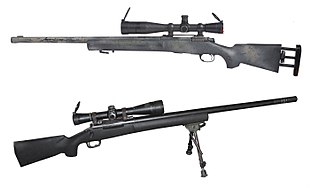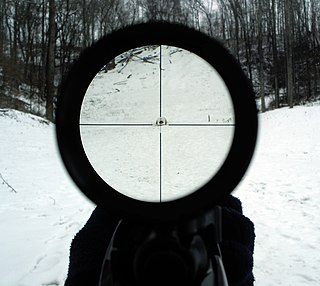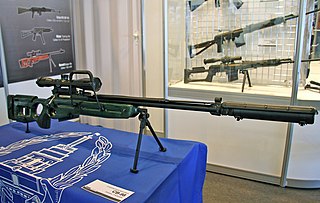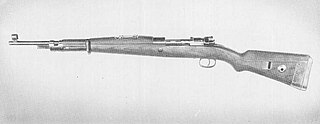This article includes a list of references, related reading, or external links, but its sources remain unclear because it lacks inline citations .(May 2015) |


The ZF41 was an optical sight produced in Germany during the Second World War.
This article includes a list of references, related reading, or external links, but its sources remain unclear because it lacks inline citations .(May 2015) |


The ZF41 was an optical sight produced in Germany during the Second World War.
Starting from 1941, the short 1.5× Zielfernrohr 41 (ZF41) telescopic sight was fitted to some Karabiner 98k rifles for designated marksman use. The ZF41 was the first attempt to provide the ordinary infantryman with a rifle capable of being used, if not for pure sniping, then at least for sharpshooting. It was initially planned to equip most combat units with the ZF41 scopes, but only 6% of German weapons production could fit the sight.
Though useful for sharpshooting with normal infantry units, the design was generally rejected by sniper schools and disliked by snipers, because the 1.5x magnifying scope was deemed insufficient for shooting effectively at point targets over long distances. Problems were the scope's extreme eye relief, poor functioning in bad light and low magnifying power. Nonetheless, lack of better telescopic sights meant the ZF39 was used by snipers at the early stages of the war in the Eastern Front, but many snipers preferred captured Soviet rifles and custom-equipped German rifles with civilian scopes such as the vintage Gewehr 98. [1]
By the end of the war in 1945, more than 100,000 ZF41 scopes had been produced, the largest production of German optical sights during the war. Approximately 3,000 were marked ZF40, 29,000 were marked ZF41 (ZF40 and ZF41 later had this etched out and ZF41/1 added when they came back for service or repair) and the rest designated ZF41/1.
The G-41(m) and G-41(w) semi-automatic rifles had ZF40 scopes added in small quantities for test and evaluation in the field. MP-43, MP-44, FG-42 automatic select fire weapons had the ZF41/1 fitted for test only, these were not produced past prototype stage, the ZF4 scope was then used on these weapons instead.
The Germans also produced a small amount of prototype and pre-production test batch of the G33/40 equipped with the ZF41. These were photographed for inclusion in the ZF41 manual in 1942. However the Brno factory switched over to the Karabiner 98k in 1943. Approximately 350 to 400 scoped G33/40 rifles were made in total. As of 2013 only one has been examined and found to be a real test batch scoped rifle: it is a late dot 1942 production rifle with serial number 3962C.[ original research? ]

A sniper is a military/paramilitary marksman who engages targets from positions of concealment or at distances exceeding the target's detection capabilities. Snipers generally have specialized training and are equipped with high-precision rifles and high-magnification optics, and often also serve as scouts/observers feeding tactical information back to their units or command headquarters.

The Mosin–Nagant is a five-shot, bolt-action, internal magazine–fed military rifle. Known officially as the 3-line rifle M1891 and informally in Russia and the former Soviet Union as Mosin's rifle, it is primarily found chambered for its original 7.62×54mmR cartridge.

The M1 Garand or M1 rifle is a semi-automatic rifle that was the service rifle of the U.S. Army during World War II and the Korean War.

The StG 44 is a German assault rifle developed during World War II by Hugo Schmeisser. It is also known by its early designations as the MP 43 and MP 44. The StG 44 was an improvement of an earlier design, the Maschinenkarabiner 42(H).

The Karabiner 98 kurz, often abbreviated Karabiner 98k, Kar98k or K98k and also sometimes incorrectly referred to as a K98, is a bolt-action rifle chambered for the 7.92×57mm Mauser cartridge. It was adopted on 21 June 1935 as the standard service rifle by the German Wehrmacht. It was one of the final developments in the long line of Mauser military rifles.

The Gewehr 43 or Karabiner 43 is a 7.92×57mm Mauser caliber semi-automatic rifle developed by Germany during World War II. The design was based on that of the earlier G41(W) but incorporated an improved short-stroke piston gas system similar to that of the Soviet SVT-40. It was manufactured using innovative mass-production techniques.

A sniper rifle is a high-precision, long-range rifle. Requirements include high accuracy, reliability, and mobility, concealment, and optics, for anti-personnel, anti-materiel and surveillance uses by military snipers. The modern sniper rifle is a portable shoulder-fired rifle with either a bolt action or semi-automatic action, fitted with a telescopic sight for extreme accuracy and chambered for a high-ballistic performance centerfire cartridge.

A telescopic sight, commonly called a scope informally, is an optical sighting device based on a refracting telescope. It is equipped with some form of a referencing pattern – known as a reticle – mounted in a focally appropriate position in its optical system to provide an accurate point of aim. Telescopic sights are used with all types of systems that require magnification in addition to reliable visual aiming, as opposed to non-magnifying iron sights, reflector (reflex) sights, holographic sights or laser sights, and are most commonly found on long-barrel firearms, particularly rifles, usually via a scope mount. Similar devices are also found on other platforms such as Artillery, Tanks and even Aircraft. The optical components may be combined with optoelectronics to add night vision or smart device features.

The Gewehr 98 is a bolt-action rifle made by Mauser for the German Empire as its service rifle from 1898 to 1935.
The Karabiner Modell 1931 is a magazine-fed, straight-pull bolt-action rifle. It was the standard issue rifle of the Swiss armed forces from 1933 until 1958 though examples remained in service into the 1970s. It has a 6-round removable magazine, and is chambered for the 7.5×55mm Swiss Gewehrpatrone 1911 or GP 11, a cartridge with ballistic qualities similar to the 7.62×51mm NATO/.308 Winchester cartridge. Each rifle included a 6-round detachable box magazine with matching stamped serial number. A stripper clip can be used to load the magazine from the top of the receiver.
The SSG 69 is a bolt-action sniper rifle produced by Steyr Mannlicher that serves as the standard sniper rifle for the Austrian Army.
The NM149 sniper rifle was developed by Våpensmia A/S in close cooperation with the Norwegian Army and is based on the tried and true Mauser M98 controlled feed bolt action. These actions originate from Mauser Karabiner 98k rifles left by German armed forces in Norway at the end of World War II in 1945. It is used by both the Norwegian military and police forces, though it was originally designed at the request of the Norwegian Army. The NM149 replaced the Kongsberg M59F1 in the Norwegian Army.

The SV-98 is a Russian bolt-action sniper rifle designed by Vladimir Stronskiy. In 2003 special operations troops were armed with the 7.62 mm 6S11 sniper system comprising the SV-98 sniper rifle and 7N14 sniper enhanced penetration round. The rifle has been used in combat during operations in Chechnya and Ukraine.
The Zastava M48 is a post World War II Yugoslav version of the Belgian designed M24 series with some influence from German Karabiner 98k. It was the standard service rifle of the Yugoslav People's Army from the early 1950s until its replacement by the Zastava M59/66, a licensed copy of the Soviet SKS semiautomatic carbine, in the early 1960s.

The major components of sniper equipment are the precision sniper rifle, various optical scopes and field glasses, specialized ammunition and camouflage materials for the sniper’s body and equipment. A sniper’s spotter typically also wears camouflage. In the 2010s, a spotter uses various optical gear and in some cases a laser rangefinder. Snipers may also use monopods, bipods or tripods to steady their aim.

The puška vz. 33 was a Czechoslovak bolt-action carbine that was based on a Mauser-type action, designed and produced in Československá zbrojovka in Brno during the 1930s in order to replace the obsolete Mannlicher vz. 1895 carbines of the Czechoslovak četnictvo (gendarmerie). The manufacturer's designation was vz. 16/33. Another version, the Vz. 12/33, was also produced for the Latin American market.

"Swedish Mausers" are a family of bolt-action rifles based on an improved variant of Mauser's earlier Model 1893, but using the 6.5×55mm Swedish cartridge, and incorporating unique design elements as requested by Sweden. These are the m/94 carbine, m/96 long rifle, m/38 short rifle and m/41 sniper rifle. Production began in 1898 at Carl Gustafs stads Gevärsfaktori in Eskilstuna, Sweden.
The evolution of German military rifles is a history of common and diverse paths followed by the separate German states, until the mid-19th century when Prussia emerged as the dominant state within Germany and the nation was unified. This article discusses rifled shoulder arms developed in or for the military of the states that later became Germany; it excludes firearms of the Austrian Empire, except where they were used substantially by German troops.
Schmidt & Bender is a German company specialized in producing high end telescopic sights for hunting, sports, law enforcement and military arms.
The PSL is a Romanian military designated marksman rifle. It is also called PSL-54C, Romak III, FPK and SSG-97. Though similar in appearance, mission, and specifications to the SVD Dragunov, the PSL rifle is, mechanically speaking, completely different as it is based on the AKM assault rifle - with its internals simply being scaled up to accommodate the more powerful 7.62×54mmR cartridge.